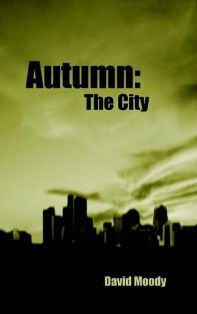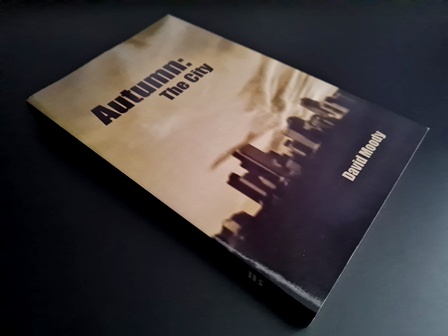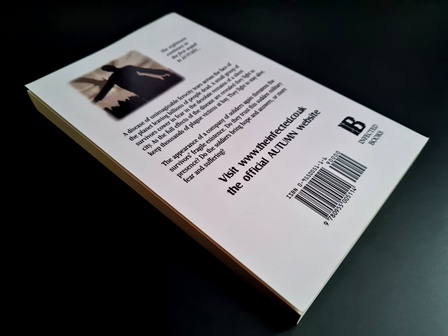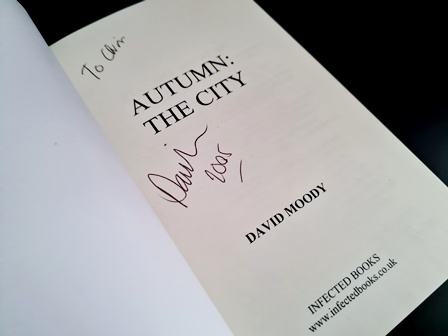
First published back in 2003, ‘Autumn: The City’ formed British author David Moody’s second instalment into his popular ‘Autumn’ series.
DLS Synopsis:
It was just another autumn day like any other when it all came crumbling down. For Donna Yorke, the day started off with her arriving early at the office for work. Then the virus hit. Suddenly one of her colleagues is collapsing in an uncontrollable coughing-fit that escalates into a choking, blood-spewing convulsion, until death takes hold. Suddenly all around her those few fellow co-workers that had made it into the office early that morning were succumbing to the same pitiful end. Yorke has no idea what’s going on, but what she does know, is that where she is seems safe for now. And so, alone in the huge empty office block, Donna Yorke holds up with the few meagre supplies she can scavenge from around the building and its vending machine.
Elsewhere, Jack Baxter has decided to leave the relative safety of his home and instead begins to hunt for fellow survivors. Sure enough he finds a young girl named Clare Smith, dressed in her school uniform and distraught from witnessing the death of her parents. Together, the two survivors take to the desolate roads, making their way towards the city centre. However, after waking from a rest within the shelter of a department store, they quickly realise that the dead are no longer just lying around where they fell, but are now up and moving around in an eerie but aimless fashion.
And then a glimmer of hope comes their way, when from out of the blue, Jack and Clare discover two fellow survivors named Bernard Heath and Nathan Holmes, driving around the city looking for supplies. They are driven back to a nearby university campus where a group of fellow survivors have banded together. People have been arriving at the university on almost a daily basis. But with the expanding numbers of people, comes the inevitable draw of the undead. And when the walking corpses turn aggressive, so the real problems begin.
Meanwhile, a number of soldiers have emerged from a secret underground military base where they have been holed up since the virus hit. However, the enemy threat is unlike anything they could have imagined or predicted. And so, after a failed mission into the city, one of their unit named Cooper finds himself cut off and left behind. Luckily salvation comes in the form of the university.
And so now with the newfound knowledge of the secure underground military facility, as the numbers of the undead surrounding the university complex swell and supplies run short, the large group of survivors inside decide to abandon their current surroundings in favour of the much more secure military base. A base that has also attracted the attention of two roaming survivors. Two survivors that since leaving the farmhouse have been living in a campervan. Two survivors named Michael and Emma…
DLS Review:
With this sequel to ‘Autumn’ (2002), the author takes the storyline back to when the virus first hits, showing the devastating effect it had on the population and the few remaining survivors, viewed from the aspect of small number of new characters.
Here, the focus is predominately within an inner urban city environment, with the death toll taken to a larger degree due to the larger numbers of deaths within the local vicinity. However, Moody continues with his character driven approach to the storyline, keeping the surviving characters at the very forefront of the plot and it’s constantly churning development.
Emotions run high once again, with the stripped down and raw exposure to this suddenly new environment, with the constant presence of danger having a dramatic (and very realistic) effect upon the characters that is displayed in their own unique ways. This ingrained empathy with (and portrayal) of a multitude of raw human emotions is one of the incredible strengths of Moody’s writing, which is displayed so vividly within the ‘Autumn’ books.
Where ‘Autumn: The City’ moves on and away from the first book is with the increased numbers of the undead and therefore the increased threat. Furthermore, Moody injects more characters and a whole new dimension to the storyline with the incorporation of an authoritarian presence – that of the army. Indeed, the inclusion of the army in this desperate dog-eat-dog environment sends out an avalanche of mixed and intriguing messages, once again with very ‘human’ qualities given within even these ranks.
The constant (but gradual) evolution of the zombies is taken a few further steps down the line, with the rotting hordes of the undead increasing in aggression and the first signs of basic thought. The zombie-timeline is kept in sync with the first novel, with the sequel progressing on further from the point in which the last novel concluded. This becomes evident to the reader with the sudden arrival of Michael Collins and Emma Mitchell from ‘Autumn’ (2002) having moved on from the farmhouse where they had been holed up. Although they only creep into the sequel much later on in the storyline, the continuation of this thread brings the two novels together to a much tighter (and more personal) degree.
Atmospherically, the book is certainly on a par with its predecessor. Donna Yorke’s reluctance to move away from the relative safety of the office block and her time spent alone in the sparse confines of the building throws out a wealth of emotion filled tension and desperate suspense. Indeed, this is very much the case for the coming together for each one of the survivors. Their individual stories are equally as poignant and emotive, whilst their strength of character is brought to the surface almost immediately. This incredible realism in the characters within such a fictional premise is what really makes the ‘Autumn’ novels what they are.
Once again this isn’t an action-packed, splatter-heavy zombie-romp. Yes you’ve got a fair few shovel full’s of glorious undead mayhem forming the main premise of the tale. But what the novel homes in on instead is the actual survivors themselves. How these individuals adapt to this dangerous new environment is what is ultimately brought out here.
The novel runs for a total of 276 pages.
© DLS Reviews
Other ‘Autumn’ instalments:
- ‘Autumn’ (2001)
- ‘Autumn: The City’ (2003)
- ‘Autumn: Purification’ (2005)
- ‘Autumn: The Human Condition’ (2005)
- ‘Autumn: Disintegration’ (2011)
- ‘Autumn: Aftermath’ (2012)
- ‘Autumn: Dawn’ (2021)
- ‘Autumn: Inferno’ (2022)
- ‘Autumn: Exodus’ (2023)
- ‘Autumn: The London Trilogy Omnibus’ (2023)










